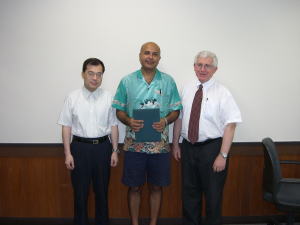Over the Years
Home > Over the Years > Over the Fiscal Years (2000 APR - 2010 MAR) > U.S.A.: Physicist Training Program
U.S.A.: Physicist Training Program
HICARE invited a physicist from California State University, Fresno, for two-month training, recommended by the "Friends of Hibakusha" in U.S.A.
Name and Position:
Amiruddin Huda
Assistant Professor, Dept. of Physics
Director, Biomedical Physics Program
Period:
June 5 to July 27, 2006
Training Organizations (in order of occurrence):
Radiation Effects Research Foundation
Hiroshima A-bomb Casualty Council
Hiroshima University Research Institute for Radiation Biology & Medicine
A visit to the Peace Memorial Museum and other A-bomb related sites
Training Course:
Epidemiological and statistical methods

With Dr. Roy E. Shore (right), Vice Chairman, and Dr. Neriishi (left), Assistant Dept. Chief, Radiation Effects Research Foundation
Impressions:
HICARE was very helpful and skilled in many aspects. I liked the flexibility with some of the elements of my training especially since my project was so different. Some suggestions I would offer are:
1 Perhaps instead of just presentations, convene a dialogue with scientists and lay people to look into things like the role of scientists in society, personal and social conflict, and its link to peace, etc.
- I would suggest a real dialogue where people really explore the issue openly and honestly rather than presentation and speeches.
2 Create a core group of specialists, physicists, medical doctors, nurses, and tie in with an organization such as the Medecins Sans Frontieres (MSF), so that in case of a radiation emergency, you would have access to any country.
- But this would require complete political neutrality.
3 Look into psychological aspects of the trauma suffered by the survivors.
- I don't find much being done in this area while I see clear signs of PTSD in some of the survivors.
I am just a medical physicist not a medical doctor. Once both parts of my DVD are edited, I would send a copy to HICARE to be distributed as needed
Note: The Contents of the educational DVD that Dr. Huda make include data such as the effects of radiation, the healthcare problems faced by the survivors, mainly for scientists, teachers, radiation workers and the general public in U.S.A.
Medical Activities in U.S.A.:
I have been very interested in the A-bomb survivors' follow-up and the sociological and scientific repercussions due to data gaps in the study. My current work involves teaching about both physics and biology of radiation effects to undergraduates. In the past I have given lectures to large audiences of radiation workers on these topics at UCLA.




